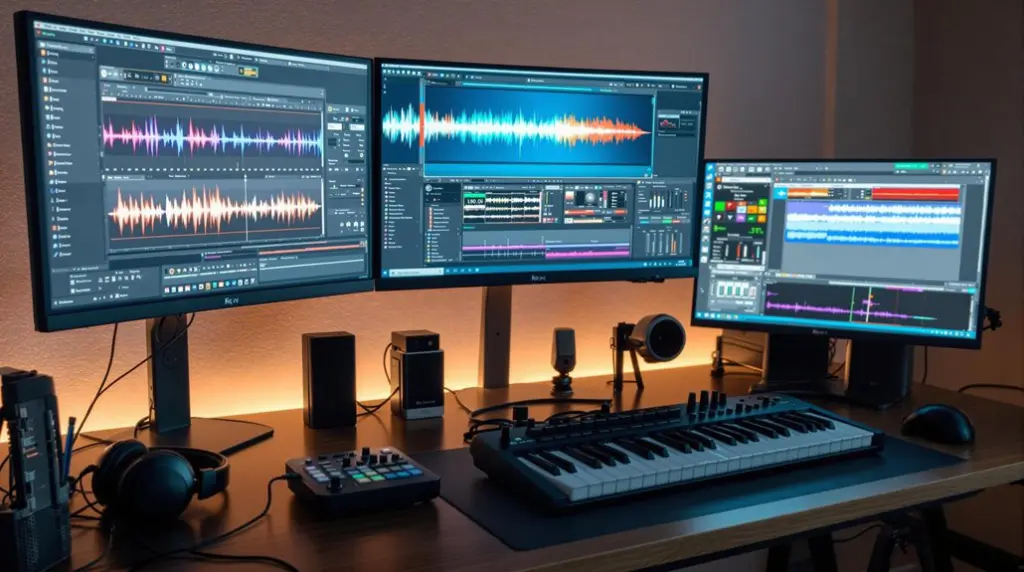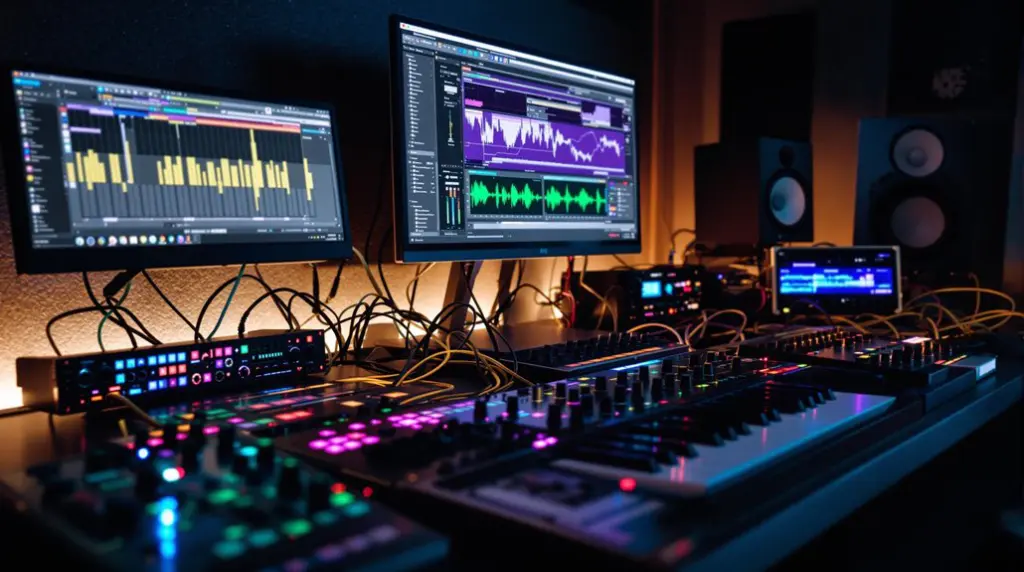The Yamaha TG77 synthesizer is a high-caliber instrument distinguished by its sophisticated FM synthesis engine, featuring 6 operators and 45 algorithms. It excels in sound design with multi-timbral capabilities for 16 simultaneous patches and combines FM synthesis with sampling for intricate, layered tones. The device includes 16 waveforms per operator and advanced envelope options for dynamic modulation. Its streamlined user interface and compatibility with the Patch Base app enhance the editing experience, offering substantial presets and community support. Exploring further reveals the extensive strengths and nuanced performance aspects of this formidable synthesizer.
Key Takeaways
- The Yamaha TG77 features a powerful 6-operator FM synthesis engine with 45 algorithms for extensive sound design possibilities.
- It supports multi-timbral functionality with 16 simultaneous patches and combines FM synthesis with sampling for complex layered sounds.
- The TG77 includes over 400 presets, providing a diverse range of sounds from lush pads to intricate bell tones.
- Advanced sound shaping is facilitated by two filters per element and dynamic modulation sources for real-time adjustments.
- The user interface and Patch Base app streamline complex sound programming, enhancing accessibility for both novice and expert users.
Overview of the TG77
Lauded for its ingenuity, the Yamaha TG77 stands as an exemplar of advanced FM synthesis, building upon the foundation laid by its predecessor, the DX7. This remarkable instrument, celebrated among aficionados of vintage instruments, features a 6-operator FM synthesis engine, which greatly enhances its sonic capabilities.
The TG77 supports 45 algorithms for operator connections, enabling intricate sound layering and customization that were previously unattainable with the classic DX7. Notably, the TG77’s architecture allows for the creation of sounds utilizing up to four distinct elements. Each element can employ its own sample playback and dual filters, offering advanced sound shaping possibilities that cater to the needs of sophisticated musicians and sound designers alike.
This multi-faceted approach to sound generation sets the TG77 apart from other vintage instruments in its class. Additionally, the TG77’s multi-timbral functionality is an indication of its versatility, permitting 16 patches to be loaded simultaneously across different channels.
This feature is particularly advantageous for creating rich, complex FM orchestras. Complemented by built-in effects units and unique Pan Tables, the TG77 offers dynamic modulation options, ensuring that it remains a powerful tool for contemporary and classic soundscapes.
Sound Design Capabilities
The Yamaha TG77’s sound design capabilities are remarkably sophisticated, featuring 45 algorithms for operator connections that offer an extensive array of routing and sound design options.
The integration of samples, combined with the advanced filtering options of two filters per element, allows for a broad and nuanced sonic palette.
Additionally, the ability to create complex, layered patches with up to four elements and the flexibility of arbitrary operator connections enable the TG77 to produce uniquely intricate sounds not achievable with older FM synthesizers.
Operator Connection Algorithms
Often celebrated for its versatility, the Yamaha TG77’s 45 different algorithms for operator connections offer a vast landscape for sound designers to explore. The sheer number of configurations allows for unprecedented operator routing and algorithm flexibility, catering to both intricate sound design and nuanced modulation.
Each algorithm can uniquely arrange up to six operators, enabling the creation of highly complex patches. This flexibility is vital for crafting detailed FM synthesis textures.
Key aspects include:
- Operator Routing: With 45 algorithms, users can experiment with a variety of operator connections, each offering distinct modulation possibilities. This flexibility is significant for creating a broad palette of sounds.
- Layered Textures: The TG77’s architecture allows each sound to consist of up to four elements. By combining multiple algorithms, users can layer sounds to achieve rich, dynamic textures that are unattainable with simpler synthesis methods.
- Intricate Patch Creation: The ability to utilize arbitrary connections between operators enhances the depth of FM synthesis. This feature empowers sound designers to push the boundaries of traditional synthesis, fostering innovation and unique soundscapes.
Sample Integration Capabilities
Integrating samples within the Yamaha TG77 greatly enhances its sound design capabilities, offering a seamless blend of FM synthesis and sampled audio. The capacity to incorporate samples alongside its robust FM engine greatly broadens the sonic palette available to users, making the TG77 a versatile tool for modern sound designers.
The unit’s ability to utilize up to four elements per sound allows for intricate layering strategies, combining FM and sampled sounds to create rich, textured patches.
One of the standout features is the TG77’s support for 16 different waveforms that can be assigned to each operator. This flexibility in waveform selection empowers users to employ advanced sample manipulation techniques, tailoring each element to specific sonic requirements.
The 45 algorithms available for operator connections further enhance the creative possibilities, offering extensive routing options that facilitate the integration of both FM and sampled elements in complex sound designs.
Moreover, the TG77’s capability to assign two filters per element provides detailed control over the tonal characteristics of the integrated samples. This advanced sound shaping tool enables nuanced adjustments, ensuring that each sample blend achieves the desired auditory effect, thereby elevating the sound design process to new heights.
Advanced Filtering Options
Building upon the TG77’s impressive sample integration capabilities, the advanced filtering options further expand its sound design potential. At the core of its filtering prowess, the TG77 boasts two filters per element, allowing for intricate sound shaping and manipulation of frequencies within a patch. This dual-filter configuration is particularly beneficial for crafting complex and evolving textures.
Key Features of Advanced Filtering Options:
- Versatile Filter Types: The TG77 supports a variety of filter types, including low-pass, high-pass, band-pass, and notch filters. This diversity enhances the versatility of sound design, enabling users to sculpt a wide range of tonal characters and dynamics.
- Dynamic Modulation Sources: Advanced modulation options allow these filters to be dynamically controlled by envelopes and other modulation sources. This capability is essential for creating evolving soundscapes, as it permits real-time adjustments to filter parameters, adding depth and movement to the sound.
- Individual Element Filtering: Each of the four elements in a sound can have its own distinct filtering settings. This feature facilitates complex layering and rich soundscapes, ensuring that each element contributes uniquely to the overall sonic palette.
Additionally, the ability to adjust filter parameters in real-time provides performers with a powerful tool for dynamic sound shaping during live performances.
Performance Features
The Yamaha TG77 boasts an impressive array of performance features that raise it above many of its contemporaries. Remarkably, the TG77’s capacity for handling 16 patches simultaneously across different channels facilitates complex multi-timbral flexibility, making it a formidable tool for live performance scenarios. This feature allows musicians to layer sounds and create intricate compositions on the fly, addressing the demands of diverse musical genres.
The TG77’s inclusion of four dedicated effects units greatly enhances its sonic capabilities, enabling real-time sound processing. For instance, performers can apply reverb and delay that enrich the live soundscape. Understanding how to utilize these effects can contribute to the emotional impact of music.
The looping envelopes on the TG77 add another dimension to its performance prowess. By enabling dynamic modulation and evolving sound characteristics, these envelopes allow for a more expressive and fluid performance.
Another standout feature is the TG77’s Unique Pan Tables, which offer sophisticated panning control. This functionality allows for precise spatial placement of sounds within a mix, adding depth and dimension to the performance.
Additionally, the TG77’s ability to create an FM orchestra through extensive routing flexibility underscores its suitability for a wide array of musical styles, from classical to electronic. These features collectively make the Yamaha TG77 an invaluable asset for any serious musician.
Comparison With DX7
When comparing the Yamaha TG77 to its predecessor, the DX7, several key differences emerge in sound synthesis capabilities, user interface, and preset library.
The TG77’s enhanced routing flexibility and 45 algorithms offer unprecedented versatility in sound design, while its advanced interface and additional envelope options provide improved user experience and expressiveness.
Additionally, the inclusion of a broader preset library and the ability to incorporate samples greatly expand the TG77’s sonic palette beyond that of the DX7.
Sound Synthesis Differences
A notable evolution in sound synthesis can be observed when comparing Yamaha’s TG77 with its predecessor, the DX7. The TG77 introduces an advanced AFM (Advanced Frequency Modulation) engine, considerably enhancing the synthesis techniques available to the user. This sophisticated engine allows for more complex sound design and richer textures.
Key differences include:
- Modulation Methods: The TG77 supports 45 algorithms for operator connections, offering a substantial boost in routing flexibility compared to the more limited options of the DX7. Additionally, each operator in the TG77 can utilize one of 16 different waveforms, unlike the fixed set of waveforms in the DX7, providing greater sonic variety.
- Hybrid Synthesis: Unlike the DX7, which is strictly an FM synthesizer, the TG77 can incorporate samples into its sound design, blending FM synthesis with AWM (Advanced Wave Memory) capabilities. This hybrid approach allows users to combine digital samples with frequency modulation, creating unique and intricate sounds.
- Envelope Options: The TG77 offers more advanced envelope options, including looping envelopes, which enable dynamic modulation of sound parameters. This is a notable improvement over the simpler envelope functions of the DX7, allowing for more expressive and evolving soundscapes.
These advancements make the TG77 a more versatile and powerful tool for sound designers and musicians alike.
User Interface Changes
One notable advancement in the Yamaha TG77 lies in its considerably refined user interface, which markedly contrasts with the more cumbersome design of the DX7. The TG77 has been lauded for its user interface benefits, particularly its intuitive layout that streamlines access to parameters and sound design options.
Unlike the DX7, which relies heavily on a matrix for operator connections, the TG77 offers enhanced routing flexibility by providing 45 algorithms and allowing arbitrary connections between operators.
Visual navigation on the TG77 is greatly improved. The extensive editor included in the TG77 serves to demystify complex sound programming, a substantial leap from the DX7’s more limited editing capabilities.
Users appreciate the TG77’s improved envelope options and multi-timbral capabilities, which contribute to a more dynamic and engaging sound design experience compared to its predecessor.
Moreover, the TG77’s user interface accommodates deeper FM synthesis techniques through its dual synthesis capabilities, making it more suitable for modern sound design needs.
This advanced interface not only makes the TG77 more accessible to new users but also empowers seasoned synthesists to explore more intricate soundscapes with greater efficiency and creativity.
Preset Library Comparison
The Yamaha TG77’s preset library, comprising over 400 meticulously crafted sounds, represents a significant evolution from the DX7’s more limited collection of 32 factory presets.
This expansion in preset diversity is a direct reflection of the synthesis evolution that Yamaha achieved with the TG77.
Key Differences Between TG77 and DX7 Preset Libraries:
- Preset Diversity: The TG77 offers a broad range of unique sounds, from lush pads to intricate bell tones. This is a stark contrast to the DX7, which, while iconic, primarily relied on its limited set of 32 factory presets.
- Synthesis Capabilities: Leveraging 45 algorithms and greater routing flexibility, the TG77 allows for complex layered sounds through its multi-element structure. This ability to create more refined metallic and ethereal textures showcases a significant advancement over the DX7.
- Sound Design Options: The TG77’s extensive library includes presets that demonstrate advancements in both synthesis technology and sound quality, making it a preferred choice for modern music production compared to the DX7.
Patch Base Integration
Patch Base Integration revolutionizes the Yamaha TG77 experience by streamlining the editing process, making sound design more accessible and efficient for users. The Patch Base app offers a user-friendly interface that markedly enhances workflow optimization. Notably, this intuitive interface parallels the simplicity found in the Splitter tool, which also encourages focus on artistry rather than technical complexities.
By enabling quick management of voice, multi, and pan banks, it simplifies the intricate task of programming the TG77.
The app’s intuitive design facilitates deep editing of every aspect of the synthesizer, making the TG77’s complex sound design capabilities more approachable. Users can easily navigate through the 45 algorithms and extensive modulation options, which are essential features of the TG77’s FM synthesis architecture. This organized access allows for a more efficient programming experience, eliminating the cumbersome nature of the original interface.
Moreover, Patch Base supports the manipulation of both FM synthesis parameters and sample playback settings. This broadens the scope of creative possibilities, empowering users to explore new sonic territories with greater ease.
Available for download from the App Store, Patch Base markedly boosts the TG77’s functionality, making it a more viable option for modern sound designers seeking efficiency and depth in their workflow.
User Experiences
While Patch Base Integration has undeniably enhanced the Yamaha TG77’s usability, user experiences reveal a more nuanced perspective on the synthesizer’s capabilities and challenges.
User feedback consistently praises the TG77 for its rich and powerful sound quality, capable of producing unique and complex textures that stand out in any musical composition. However, the editing process is often cited as time-consuming and cumbersome, particularly for those accustomed to more intuitive, modern interfaces.
Many TG77 owners initially experience confusion when programming operator selections and maneuvering the synth’s intricate features. This steep learning curve can dampen initial enthusiasm, although the extensive sound design capabilities remain a significant draw for dedicated users.
The synth’s dual capabilities—AWM and AFM—offer a versatile range of musical styles, despite some criticisms of the AWM elements.
To further understand the TG77, consider the following user insights:
- Sound Quality: Users laud the TG77 for its ability to produce rich, powerful, and complex textures.
- Editing Challenges: The editing process is often seen as cumbersome, especially for those new to the TG77.
- Learning Curve: Initial confusion is common, necessitating robust learning resources for mastery.
These insights underscore the TG77’s profound capabilities and the need for thorough learning resources to fully leverage its potential.
Technical Specifications
Among the key attributes of the Yamaha TG77 is its formidable dual synthesis engine, which integrates 6-operator FM synthesis with advanced sampling capabilities. This powerful combination allows for a broad palette of sound design possibilities, making it ideal for both experimental and traditional musical applications. The TG77 provides 45 different algorithms for operator connections, offering a wide range of routing options that facilitate complex synthesis techniques.
One of the standout features of the TG77 is the ability to support up to 16 patches loaded simultaneously. This multi-timbral capacity is vital for live performances and studio environments where diverse soundscapes are required. Each element within a patch can utilize two filters, enabling intricate sound shaping and enhanced sonic depth.
| Feature | Description |
|---|---|
| Synthesis Engine | Dual (6-operator FM + Sampling) |
| Algorithms | 45 different operator connection algorithms |
| Patch Capacity | Up to 16 patches loaded simultaneously |
| Filters per Element | Two filters per element in a patch |
In addition to its synthesis prowess, the TG77 is equipped with looping envelopes and real-time controllers. These features provide advanced modulation possibilities, essential for dynamic performance and sophisticated sound sculpting. Effective patch management and the depth of synthesis techniques make the TG77 a versatile and powerful tool for sound designers and musicians alike.
Community Insights
Given the vibrant community engagement surrounding the Yamaha TG77 on platforms like Gearspace, it becomes evident that this synthesizer has garnered a loyal following among sound designers and musicians.
The collective knowledge shared by users is invaluable, especially when it comes to traversing the complexities of FM synthesis and maximizing the TG77’s capabilities. Blogs and forums often provide valuable resources for skill enhancement, which is essential for mastering such intricate equipment.
The Gearspace community often explores detailed discussions that reveal both the strengths and weaknesses of the TG77. Here are some key takeaways:
- Community Tips: Users frequently exchange tips and tricks for crafting intricate patches, providing practical advice that can be pivotal for both novices and seasoned programmers.
- Editing Challenges: Many members candidly share their experiences with the TG77’s editing interface, highlighting the steep learning curve but also offering solutions and workarounds that can alleviate some of the frustrations.
- Resource Sharing: The community provides valuable resources such as PDFs, tutorials, and links to sound banks, fostering a collaborative environment where continuous learning and exploration are encouraged.
These insights not only enhance individual user experiences but also contribute to the ongoing evolution of the TG77’s usage and appreciation within the music production domain.
Frequently Asked Questions
When Did the Yamaha Tg77 Come Out?
The Yamaha TG77, with its release date in 1991, marked a pivotal moment in synthesizer technology. Its historical impact lies in advancing FM synthesis, solidifying its status as a versatile and powerful tool in the music industry.
What Are the Specs of the Yamaha Cs1x?
The Yamaha CS1x synthesizer features 32-voice polyphony, a 4-operator FM engine for advanced sound design, 16-voice multi-timbrality, a 61-key synth-action keyboard, and onboard effects like reverb and chorus, enhancing its versatile synthesizer capabilities.
Conclusion
The Yamaha TG77 synthesizer exemplifies a significant advancement in sound design and performance capabilities. Its synthesis engine surpasses that of the DX7, offering unprecedented depth and flexibility. Integration with Patch Base enhances its usability, while user experiences and community insights attest to its enduring relevance. With robust technical specifications, the TG77 remains a powerful tool for both professional and amateur musicians, cementing its status as a seminal instrument in the evolution of digital synthesis.




